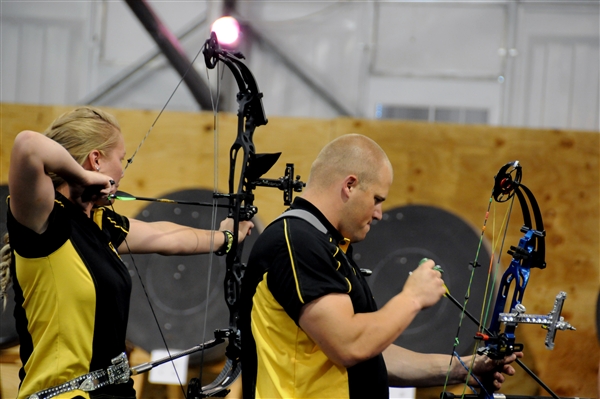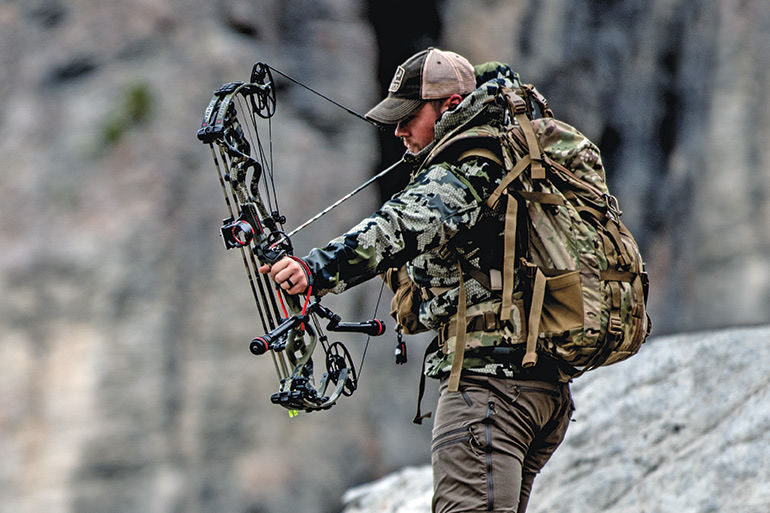How to Shoot a Back Tension Release
How to Shoot a Back Tension Release
At ArcheryHistorian.com we are usually deal with historical and traditional archery. However, we love all archery! Also, we like to stay on the cutting edge. That is why we wrote this article on how to shoot a back tension release for modern archers.
Drawing a bow involves back tension of some degree. The muscles of the back contract the shoulder blades together toward the spine during the movement of drawing a bow. But what about the release itself? Can back tension itself be used as the mechanism of release? The answer is yes. If you want to learn more about how to shoot a back tension release, you came to the right place. This article will discuss the intricacies of back tension as well as how and why many modern compound and recurve archers are executing shots with a back tension release.

Anxiety and Anticipation
When taking a bow to full draw, particularly a modern compound or recurve with sights, have you ever panicked just as the sight came across the bullseye or target? Maybe you released the arrow right away, slightly prematurely. Or even worse, the shot was very premature and the sight had not yet even reached the sweet spot. This is something many archers encounter in their practice, it is a certain anxiety that develops in anticipation of the release.
The body and subconscious are anticipating the exciting and sudden release of the energies stored within the bow and while this anticipation is natural, it must be controlled in archery. If it is left uncontrolled, the archer may experience target panic and punch the shot. This, of course, is to be avoided if the archer desires accurate and consistent shots.

There is however a way to trick the body and the mind to a certain degree, to dampen the anxiety of anticipation and to eliminate target panic. There are mental techniques that can be employed to assist in training the mind and body to address target panic. But what about the release itself? Indeed with the appropriate release aid, the shot could be engineered so that anxiety anticipation is dampened by eliminating a trigger mechanism.
A back tension release aid or a hinge release releases the string when a certain amount of pressure is applied. That is the essence of how to shoot a back tension release. To make the shot a “surprise” to the archer. There is no trigger with this type of release aid. The pinching of the should blades together in order to complete the draw, aka back tension, is what releases the shot. As mentioned, this release is becoming more and more popular among modern archers.
The Back Muscles in Archery
As you may already know, the muscles of the back are heavily involved in the drawing of a bow. The main muscles in the back are the trapezius, rhomboids, and the latissimus dorsi. Contracting these muscles draws the shoulder blades together and expands the chest. This is the movement we are after when drawing a bow. This is the natural movement we will utilize as the means of release. If you would like to know more about archery anatomy or strengthening your archery muscles, CLICK HERE.

Back Tension Release or Hinge Release
Now let us look at the actual mechanical device we’ll use as our release aid; the back tension or hinge release. The mechanisms themselves vary in design and ergonomics, but the fundamental principles are the same. Some variants incorporate a two, three, or four-finger design. The thumb engages a safety mechanism on many models. The safety holds the hook which engages the string in place so it will not release.

A crescent or half-moon shape pivots around a pin which sets the release sensitivity (the pressure at which the string releases). A freely moving hinge rotates around a second pin which is often referred to as the gate. A rotating motion, ultimately caused by back tension, initiates a searing mechanism to slip, thus opening the hook, releasing the arrow. If this sounds complicated and overly technical, don’t worry. All you really need to know is that the back tension release aid is a triggerless, handheld aid, that releases the arrow when sufficient pressure and rotation are applied.

A safety that locks the release in place during the initial phase of the draw is typically located so as to be easily activated by the thumb. When shooting a compound bow, this safety is engaged during the first part of the draw, then released as the bow lets off.
Another mechanism can be included with the back tension release device. This is known as a “clicker”. As the name implies, this device makes a clicking noise just before the device releases. With a clicker in place, the archer knows that the shot is about to release. Some archers prefer this auditory indicator when utilizing a back tension release.
Back Tension Vs Trigger Release
These days, many variations of release aids exist for modern archers. The main difference between a back tension release and trigger release is quite obvious. A back tension release lacks a mechanical trigger. The trigger is back tension. A summarized list of the advantages of a back tension release as opposed to a trigger release follows:
- Encourages proper form and proper anatomical alignment.
- Alleviates the anxiety of anticipation, which can cause target panic
- Can add an element of excitement to each and every shot. It’s like watching a toaster that is about to eject the toasty goods. You know it’s coming, but it gets you every time it pops.
- Along with encouraging good form, practicing a back tension release helps build strong archery muscles, particularly the back muscles.
- Builds awareness of archery muscles and draw form.
Give the back tension release a try!
Here are some popular back tension release aids available on the market right now:
Stanislawski PerfeX Resistance
A very versatile and adjustable back tension release aid. Comes in a variety of different sizes to fit hands of all kinds. This tension release aid had a thumb safety and the resistance can be very fine-tuned. CLICK IMAGE FOR MORE!
T.R.U. Ball Falkrum Flex
Super-sleek design and feel. Easily adjustable and worry-free. T.R.U. Ball is known for their quality craftsmanship when it comes to release aid archery equipment. CLICK IMAGE FOR MORE!
Scott Archery Sigma Release Metal 3 Finger
A great 3-finger archery release with all the fixings at a good price. This release has an elegant ergonomic design and feel. Also, it is easily adjustable and reliable, machined from 440 stainless steel. You will be letting shots fly with great accuracy for years to come! CLICK IMAGE FOR MORE!
Shot Execution with Back Tension Release
Like with many other pursuits in life, learning how to shoot a back tension release can take a relatively short amount of time. Mastering the skill, however, can take some considerable practice. Some pick it up faster than others, just like with many other things. The basic steps for executing the shot with a back tension release aid are as follows:
- Adjust the back tension release aid so that it will release at the desired pressure (see section “Adjusting a Back Tension Release Aid”)
- With the safety engaged with the thumb, engage the hook onto the bowstring.
- Keeping the safety engaged, draw the bow as you normally would.
- Reach your desired anchor point.
- Aim and set your target within your sights.
- Release the safety.
- Using back tension, slowly continue to pinch you shoulder blades together while slightly relaxing the draw hand.
- Surprise! The aid will release and the arrow will fly. Repeat as necessary.
Check out this video which breaks down the back tension release further:
Adjusting a Back Tension Release Aid
A bow draw weight scale should be used to fine-tune your hinge release aid. Simply use this scale and when drawing your bow to determine the draw weight the release aid will be subjected to after let off (compound bow). Then use the release aid to hook into and pull on the draw weight scale. Make adjustments so that the release unhooks at or around the weight of your bow at full draw. You can then try the release aid on your actual bow. This is not an exact science and you may have to do a little back and forth when it comes to adjustment. A little experimentation if you will.
A set of Allen keys is typically all that is required to adjust the back tension release. Some release aids have the tensioning tool build into the handheld device itself.
Trial and error are unavoidable in fine-tuning your back tension release aid. But once you are satisfied, the result is very well worth the effort.

Back Tension Release for Hunting
Not only has the back tension release method become more prevalent with target shooting, but many bowhunters nowadays also shoot with this style of release method. The same principle and reasons apply in hunting as they do in competitive target shooting or just recreational fun. Hunters do not want any target panic or shot anxiety when the game is within their sights. Utilizing a back tension release seems like the obvious answer. Punching a shot while hunting can be even more frustrating than with target shooting, as the game may not be around for a second attempt if the first is fouled.


